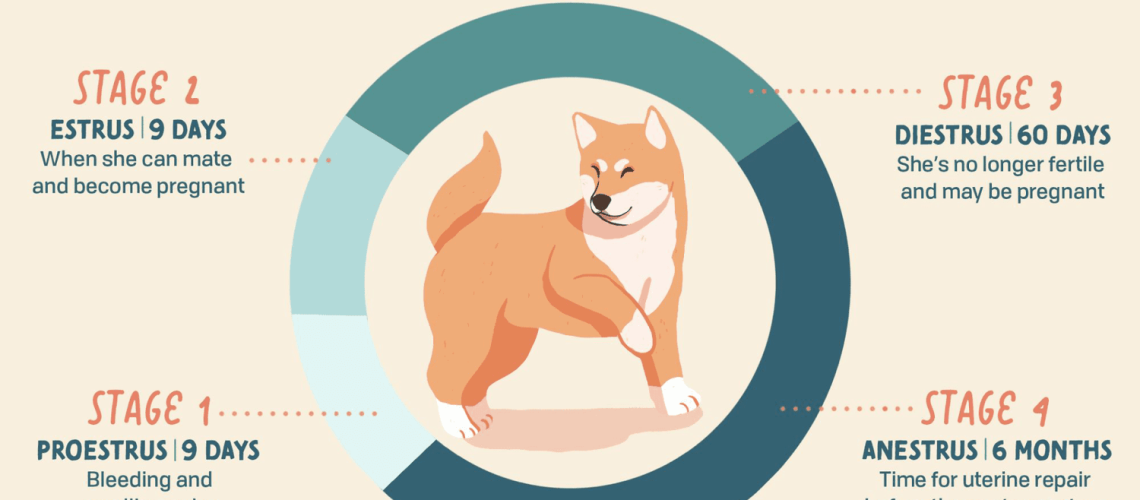Key Takeaways:
- The first sign of a dog in heat is swelling and discharge from the vulva.
- Behavioral changes, such as increased restlessness and frequent urination, can indicate that a dog is in heat.
- A dog in heat may attract male dogs and show signs of receptive behavior, such as flagging her tail or assuming a mating position.
- Dogs in heat may experience mood swings and become more aggressive or irritable towards other dogs or humans.
- It is important to keep a dog in heat away from intact male dogs to prevent unwanted pregnancies.
Is your furry friend acting a little different lately? Well, it could be because they are in heat! Understanding the signs that your dog is in heat is essential for any responsible pet owner. Not only will it help you provide the necessary care and attention during this time, but it can also prevent any unwanted surprises down the road. In fact, did you know that approximately 85% of unplanned litters are a result of dogs being in heat? So, if you want to keep your pup happy and avoid any unexpected additions to the family, keep reading to discover 8 telltale signs that your dog is in heat. Get ready to become an expert on all things canine reproduction!
Signs that a Female Dog is in Heat
When a female dog is in heat, there are several signs that can help you determine her condition. One of the most noticeable signs is swelling of the vulva, which is the area around the opening of her reproductive tract. This swelling usually occurs at the beginning of her heat cycle and can last for about two weeks. Additionally, you may notice a discharge from her vagina, which can range in color from clear to bloody. This discharge helps attract male dogs and can be a strong indicator that she is in heat.
Another sign to look out for is changes in your dog's behavior. During her heat cycle, she may become more affectionate and seek attention from you or other animals. She may also become more restless and exhibit pacing or nesting behaviors. It's important to keep an eye on her during this time as she may try to escape or wander off in search of a mate.
How Often a Female Dog Goes into Heat
A female dog typically goes into heat, also known as estrus, about twice a year. The exact frequency can vary depending on the breed and individual dog. Smaller breeds tend to have more frequent cycles, while larger breeds may have less frequent cycles. It's important to note that not all dogs will have regular cycles, and some may experience irregularities or skip cycles altogether.
The duration of each heat cycle can also vary but typically lasts for about three weeks. During this time, she will go through different stages, including proestrus (the initial phase with swelling and discharge), estrus (when she is fertile), and diestrus (the final phase before returning to normal). It's crucial to keep track of your dog's cycle so that you can anticipate when she will be most fertile and take appropriate precautions if you do not want her to become pregnant.
Can Male Dogs Sense When a Female Dog is in Heat?
Yes, male dogs have a keen sense of smell that allows them to detect when a female dog is in heat. They can pick up on the pheromones released by the female dog's body, even from a distance. This ability to sense a female in heat can make male dogs more alert and focused, as they are driven by their natural instincts to mate.
Male dogs may exhibit different behaviors when they sense a female in heat. They may become more restless, agitated, or even aggressive towards other male dogs. Some males may try to escape from their homes or yards in search of the female. It's essential to be cautious during this time and keep your female dog securely confined if you do not want her to mate.
Keeping Your Female Dog Indoors During Her Heat Cycle
It is crucial to keep your female dog indoors during her heat cycle for several reasons. Firstly, keeping her indoors prevents unwanted pregnancies if you do not intend to breed her. Male dogs can detect females in heat from miles away and will go to great lengths to reach them. By keeping your female indoors, you can ensure that she does not come into contact with intact males and reduce the risk of unplanned litters.
In addition to preventing unwanted pregnancies, keeping your female dog indoors also protects her from potential dangers and risks associated with being outside while in heat. During this time, she may attract unwanted attention from male dogs who could become aggressive towards her or cause fights among themselves. There is also an increased risk of accidental injury or getting lost if she tries to escape in search of a mate.
To keep your female dog comfortable during her heat cycle indoors, provide her with a quiet and secure space where she can rest. Make sure she has access to fresh water and a comfortable bed or crate. It's also a good idea to keep her on a leash or harness when taking her outside for bathroom breaks to prevent any encounters with male dogs.
Behavioral Changes When a Female Dog is in Heat
When a female dog is in heat, she may exhibit several behavioral changes that are characteristic of this reproductive phase. One common behavior is increased vocalization, where she may bark or whine more often than usual. This vocalization serves as a way for her to communicate with potential mates and attract their attention.
Another behavioral change you may notice is increased urination. Female dogs in heat may urinate more frequently and mark their territory with urine as a way of signaling their availability to males. This behavior is driven by hormonal changes during the heat cycle.
Additionally, your female dog may become more affectionate during this time and seek attention from you or other animals. She may rub against furniture or people, display more frequent tail wagging, and show signs of restlessness or pacing. These behaviors are all part of her natural instinct to find a mate and reproduce.
Tips for Keeping Your Female Dog Comfortable During Her Heat Cycle
During your female dog's heat cycle, there are several things you can do to help keep her comfortable. Providing her with a quiet and secure space where she can rest undisturbed is essential. Create a cozy area with soft bedding where she can relax comfortably.
It's also important to keep her surroundings clean and hygienic during this time. Regularly clean any discharge she may have using pet-safe wipes or warm water and mild soap if necessary. This will help prevent any discomfort or irritation caused by the discharge.
Additionally, consider using special doggie diapers or sanitary pants designed for dogs in heat. These can help contain any discharge and keep your dog clean. Make sure to change the diapers or pants regularly to maintain hygiene.
Finally, provide plenty of mental and physical stimulation for your female dog during her heat cycle. Engage her in interactive play sessions, provide puzzle toys, and take her on leashed walks to help alleviate restlessness and keep her mind occupied.
Health Concerns and Risks of a Female Dog Being in Heat
When a female dog is in heat, there are certain health concerns and risks that you should be aware of. One common issue is the potential for pyometra, which is a serious infection of the uterus. During the heat cycle, the uterus becomes more susceptible to bacterial infections. If left untreated, pyometra can be life-threatening for your dog. It's important to monitor your female closely for any signs of illness such as lethargy, loss of appetite, excessive thirst, or vaginal discharge with a foul odor.
Another risk during this time is unwanted pregnancies if you do not intend to breed your female dog. Male dogs can detect females in heat from a distance and may try to mate with her even if she is not receptive. Unplanned litters can lead to additional health risks for both the mother and puppies.
To mitigate these risks, it's essential to consult with your veterinarian about appropriate preventive measures such as spaying (removing the ovaries and uterus) or using hormonal contraceptives. These options can help prevent both pyometra and unplanned pregnancies while ensuring the overall health and well-being of your female dog.
In conclusion, it is important for dog owners to be aware of the signs that indicate their female dog is in heat. By recognizing these signs early on, owners can take appropriate measures to keep their dog safe and prevent unwanted pregnancies.
Can a dog be on heat and not bleed?
A silent heat cycle refers to when a female animal goes through a heat cycle without displaying the usual signs such as bleeding and vulva swelling. Despite this, the female can still mate with males and become pregnant. Veterinarians can confirm a silent heat cycle by conducting tests like vaginal cytology and progesterone assays.
What time of year do dogs go into heat?
Unspayed female dogs experience a heat cycle twice a year, approximately every 6 months. This cycle typically lasts for about 18 days, or roughly 2 to 3 weeks. The exact frequency may vary for each dog, but it is important for her estrus cycles to be regular.
What is a silent heat in female dogs?
Certain dogs may go through a condition known as silent heat, where they still ovulate but do not show the usual signs of being in heat, such as swelling and discharge. Additionally, although uncommon, some dogs may have an autoimmune disease that impacts their ovaries and disrupts their reproductive cycle.
How long does a dogs first heat last?
A dog's season, or fertile period, typically lasts for approximately two to four weeks. During this time, the dog may exhibit changes in behavior and physical appearance as a result of fluctuating hormones.
What changes in dog before heat?
Typical indications that a female dog is entering her heat cycle include frequent urination, altered behavior (such as increased need for attention), swollen vulva, and the presence of bloody vaginal discharge. It is worth mentioning that these symptoms can differ based on the specific breed of your dog.
Do dogs behave differently when in heat?
Female dogs may show signs of entering heat such as decreased energy, increased aggression, changes in urination posture, more frequent urination, and possibly even attempting to run away. It's important to note that male dogs do not go through heat cycles.
















